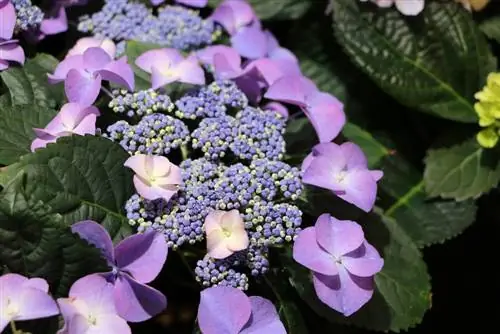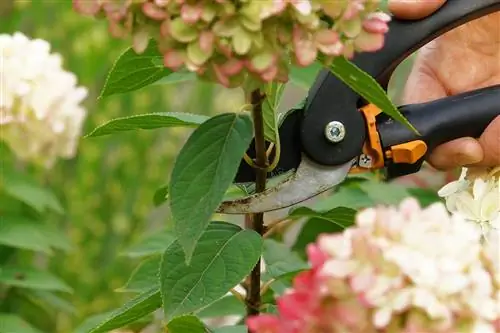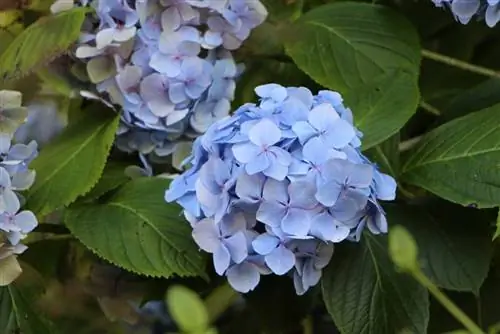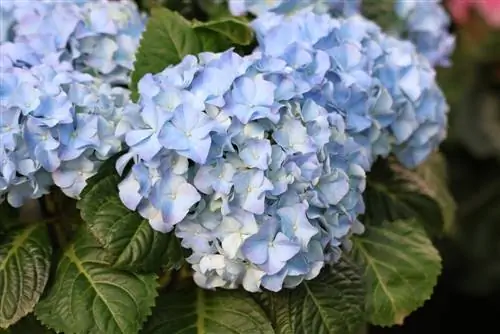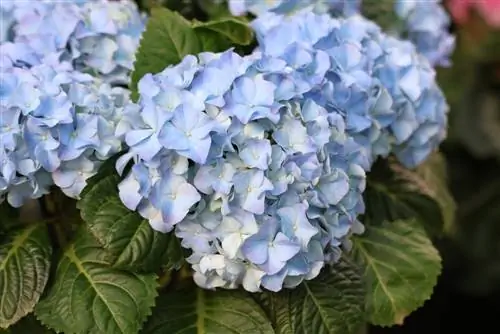- Author admin [email protected].
- Public 2023-12-17 03:39.
- Last modified 2025-06-01 06:48.
The hydrangea is a lush flowering and very decorative plant that gives the garden a special character. Unlike the very well-known farmer's hydrangea, the plate hydrangea comes from Asia. The plate hydrangea is particularly beautiful because it appears much more delicate than the farmer's hydrangea. So why not add this robust plant to your own garden?
Varieties
Overall, there are many types of hydrangeas. Below are the most important varieties for our climatic rooms:
- The Acuminate is a very delicate type of hydrangea that impresses with steel blue inner flowers and pink edge flowers. The Grayswood is a plate hydrangea that has pink inner flowers and white border flowers, which then turn an attractive carmine red after the plant has actually bloomed.
- The Rosalba variety differs from the other plate hydrangeas in its umbrella-shaped inflorescence, which has the shades of pink or blue in the inner flower, the marginal flowers are initially white and turn into an attractive carmine pink after the actual flowering.
- The Intermedia variety has white marginal flowers with a touch of blue that attractively surround the dark blue inner flowers. The special feature of the Intermedia variety, among others, is that the marginal flowers have a pink tone in highly alkaline soils.
- The Tiara variety hydrangea has the same colored inner and peripheral flowers, which, however, have a more blue color on acidic soils, while they are both more pink on alkaline soils. The foliage of the Tiara variety is particularly attractive, as it takes on an interesting red-purple color towards autumn. The Tiara variety reaches a maximum height of about one meter.
- The Miyama-yae-murasaki variety has double-double, sterile marginal flowers that are either blue or pink depending on the soil. This variety reaches a height of up to 1.5 meters. Since all hydrangeas come from Asia, they have similar requirements in terms of care and location.
Location requirements
The hydrangea has its original home in the rainy mountain forests of Japan and Korea. This origin also determines the requirements that the hydrangea places on its location and the soil conditions of this location. A location in light shade is perfect. The plant can only tolerate a very sunny location if it is provided with sufficient moisture. The soil for the hydrangea should be nutrient-rich, humic and filled with airy pores. When it comes to the pH value of the soil, the plate hydrangea has a tolerance range of five to eight, with the leaves of the individual varieties coloring differently depending on the pH value of the soil. The hydrangea doesn't mind a slight lime content in the substrate.
As far as location is concerned, the hydrangea feels particularly comfortable in the environment of deep-rooted deciduous trees, as it knows how to use these advantages to its advantage. Thanks to a dense canopy of leaves from surrounding trees, the hydrangea is well protected from both excessively hot sunlight and heavy rain, but still receives mild sunlight. Due to its more delicate nature than the farmer's hydrangea and a height of usually around 100 cm, this plant can fit in very well in perennial borders if it receives an adequate supply of water. The botanical name of the hydrangea is Hydrangea, which translates as “water vessel” or “a lot of water” and thus makes clear the important care requirements that the hydrangea has.
The plate hydrangea appreciates:
- a light shaded location
- intensive water supply
- stale rainwater
- a humus-rich soil with airy pores
- the neighborhood of deep-rooted deciduous trees as sun and rain protection
Ideal planting time/care
It is best to plant the hydrangea in May. After planting, abundant watering is very important. If the hydrangea is kept as a pot plant, intensive water supply is particularly important, although waterlogging should be avoided at all costs. This plant prefers to be supplied with soft, low-lime rainwater, which is collected in the rain barrel and is therefore stale. The particularly high water requirement of the hydrangea, even in shady locations, is easily explained because the plant has a large leaf surface, which ensures intensive water evaporation even outside of the flowering period. That's why the hydrangea depends on intensive watering not only when it's in bloom - like many other plants - but all year round, as long as it has leaves and it doesn't freeze outside. By the way, the plant produces its flowers from June to September.
Wintering
The plate hydrangea has no problem with outside temperatures around freezing point and it also copes very well with light frost. However, if the winter is colder than 0 °C, then the plant should be protected from the cold. The root area can be protected from the cold with a dense layer of straw or leaves or brushwood. The shoots and branches of the plant are protected from frost with garden fleece or bubble bags or jute bags. On frost-free days, the plant should be provided with a little soft water to prevent existing flower buds from drying out. Only when the temperatures rise permanently above 0 °C should the winter protection be removed - but then quickly, otherwise there is a risk of mold forming. However, the plant cover should still be kept handy in case of possible late frosts. In the pot, the hydrangea is exposed to the risk of the root ball freezing completely. That's why potted plants should definitely move to a frost-free but cool winter quarters in the winter. Of course, the plants must not dry out there either.
The plate hydrangea:
- is winterproof until freezing point
- needs good protection for roots, shoots and branches in frost
- must also be protected from late frosts with covers until May
- As a container plant, it should be protected from frost but kept cool over the winter
Make the hydrangea bloom
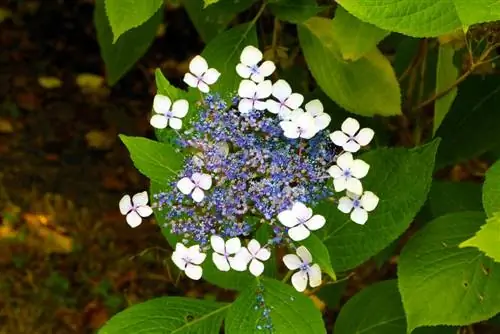
If the hydrangea does not bloom as desired, there can be various reasons. Incorrect pruning and removal of flowers for next spring will reduce the plant's ability to bloom. Even late frosts to which the plant was exposed unprotected can lead to bud damage and thus a lack of flowers. Until mid-May, hobby gardeners should always keep the cover for the hydrangea on hand for the frosty nights.
Cutting
Even if the withered leaves in late autumn tempt almost every hobby gardener to cut them, you should avoid doing so, as the hydrangea may suffer as a result. Because most varieties produce their flower buds in the previous year's wood, cutting them too early and too intensively can cost the next year's blooms. Experienced hobby gardeners are also familiar with the habit of hydrangea, which sheds its leaves but allows the dried inflorescences to remain on the bush until next spring. In winter these are even decorative when they are covered with frost or hoar frost or snow. Light pruning should only take place in spring to support the approaching flowering. Then it is important to cut off the frozen shoot tips and cut out all dead wood near the ground as well as remove the inward-facing branches. Crossing shoots and wilted leaves are also removed in spring.
The cut should take place just above the new buds and no long branch stubs should be left standing. To maintain the he alth of the plant, only sharp and thoroughly disinfected cutting tools should be used, as branches and shoots must under no circumstances be crushed. Testing whether a shoot is still alive is easy. If you scratch the bark a little with your nail and green appears, then the shoot is alive and should not be pruned. Regular maintenance pruning prevents the plant from balding from below. If the hydrangea appears stunted due to inadequate pruning, it can be saved after two to three years by rejuvenating it to a height of 15 to 20 cm.
Care cutting for garden and plate hydrangeas
Pruning these hydrangeas can therefore simply be limited to the necessary care:
- First, as already mentioned above, you should remove the old inflorescences. But only in spring, because only then can you clearly see the new flowers that the plant has already formed in the coming season and run little risk of removing the new one along with the old one. The new buds develop under the old flower and are cut just above it.
- You should also take this opportunity to check whether your hydrangea had to sacrifice some of its shoot tips to frost over the winter. These dead shoots are then cut off to where the he althy tissue begins (where green color appears under the bark).
- You can also thin out the entire plant a little if it has grown too densely inside. You should make sure to always prune the oldest shoots, which can then be cut back to ground level.
If your garden hydrangea feels so comfortable with you that it is growing really hard and is slowly getting too big, you can also prune it more heavily. However, you will then almost inevitably also cut into the newly created inflorescences, which means that you will only see very few flowers in the season after such a radical cut.
New varieties make cutting easier
If you don't feel like examining every single branch before cutting a garden plant to see whether there are new buds or not, you could get a new hydrangea variety that frees you from such considerations: the hydrangea “Endless Summer”, a new variant of the garden hydrangea, was persuaded by its breeders to develop flower buds on fresh shoots. That's why you can't go wrong when pruning, you simply remove the spent ends from which the "Endless Summer" can produce new flowers several times a year.
Even with frozen shoots you will have little burden with this variety, it can withstand winter temperatures down to minus 30 degrees. If you also want to free yourself from worrying about the pH of the soil and the pink or blue flowers that come with it, buy an “Endless Summer” of the variety “The Bride”, which produces beautiful pure white flower balls in any soil. You can find out more about the new variety on the website www.hortensie-endless-summer.de.
Frequently asked questions
What to do - my hydrangea doesn't want to bloom?
Lack of nutrients or cutting live shoots are the main reasons why the plant fails to bloom. If the cut is done correctly, a soil test from the garden center should be carried out to check the soil, which shows the pH value of the soil. An optimal pH value and a special hydrangea fertilizer cause most plants to bloom. However, you should urgently use a hydrangea fertilizer because, unlike other fertilizers, it has a low phosphorus content.
Which pests are dangerous for hydrangeas?
The spider mite likes to attack the hydrangea if it is kept too dry. Thoroughly showering the plants and spraying them with a spray containing rapeseed oil can help. To strengthen the plant, you should then consider changing the location with more sun protection.
What you should know in brief
- Pranicle hydrangeas are among those that need pruning to become beautifully bushy. Cut them back to approx. 50 cm after the last frosts.
- If you ever need to prune a hydrangea severely, it is entirely possible. However, you have to forego the flowering next year.
- The hydrangeas must not be pruned either. The primordia for the new flowers form during flowering. If you cut off more than just the spent flower balls, you will remove the beginnings of the flowers for the coming year and the hydrangea will not bloom.
- A simple solution to cutting back and still getting flowers is to spread the cutting over a few years. You only cut back a few branches at a time. These won't bloom, but the rest of the plant will make up for it by continuing to bloom beautifully.
- In addition, individual, heavily woody shoots can be completely removed from older plants. This stimulates the formation of new ground shoots.

